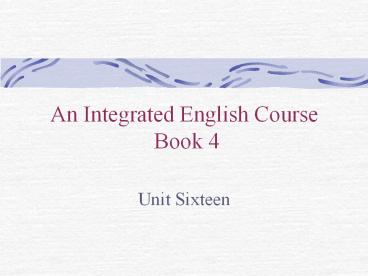An Integrated English Course Book 4 - PowerPoint PPT Presentation
1 / 120
Title: An Integrated English Course Book 4
1
An Integrated English Course Book 4
- Unit Sixteen
2
Text I The Story of an Eyewitness
- How do you understand the title?
- Who is this eyewitness? What do you know about
him or her? - What is the story about?
3
Background information
- About the article (Note 1)
- About the author (Note 2)
- About the city, San Francisco (???)
- --the fourth largest city in California and the
14th largest in the United States the second
most densely populated major city in the US. - Located on the tip of the San Francisco
Peninsula, surrounded on three sides by the
Pacific Ocean and San Francisco Bay.
4
(No Transcript)
5
San Francisco
6
About the 1906 San Francisco earthquake
Burning of San Francisco, Mission District
7
Basic information
- Date April 18, 1906
- Magnitude 7.8 Mw
(???Moment magnitude scale) - Depth 80 Kilometers
- Epicenter location San Francisco
- Countries/regions affected United States
(San Francisco Bay Area) - Casualties 3,000 killed
8
San Francisco earthquake of 1906
- The San Francisco earthquake of 1906 was a major
earthquake that struck San Francisco, California
and the coast of Northern California at 512 A.M.
on Wednesday, April 18, 1906. - The most widely accepted estimate for the
magnitude of the earthquake is a moment magnitude
(Mw) of 7.8 however, other values have been
proposed from 7.7 to as high as 8.3.
9
- The main shock epicenter occurred offshore about
2 miles (3 km) from the city, near Mussel Rock.
It ruptured along the San Andreas Fault both
northward and southward for a total length of 296
miles (477 km). - Shaking was felt from Oregon to Los Angeles, and
inland as far as central Nevada. The earthquake
and resulting fire is remembered as one of the
worst natural disasters in the history of the
United States. The death toll from the earthquake
and resulting fire, estimated to be above 3,000,
represents the greatest loss of life from a
natural disaster in California's history. The
economic impact has been compared with the more
recent Hurricane Katrina disaster. - (http//en.wikipedia.org/wiki/1906_San_Francisco_e
arthquake)
10
Subsequent fires (1)
- As damaging as the earthquake and its
aftershocks were, the fires that burned out of
control afterward were much more destructive. It
has been estimated that as much as 90 of the
total destruction was a result from the
subsequent fires. Due to the nearly universal
practice of insurers to indemnify (??) San
Francisco properties from fire but not earthquake
damage, most damage within the city was blamed on
the fires.
11
Subsequent fires (2)
- It is probable, due to the extreme magnitude of
the earthquake and the poor buildings standards
of the time, that a majority of structures
destroyed that day were initially destroyed from
the movement of the earth before succumbing to
fire. Fires broke out in many parts of town, some
initially fueled by natural gas mains broken by
the quake. Other fires were the result of
arson(??) and campfires set by evacuees.
12
- Worst of all, many were set when firefighters
untrained in the use of dynamite attempted to
dynamite buildings to create firebreaks(???),
which resulted in the destruction of more than
half of buildings that would have otherwise
survived. The fire chief, who would have been
responsible, had died in the initial quake. The
dynamited buildings themselves often caught fire.
The fires lasted for four days and nights.
13
Subsequent fires (3)
- Some property owners set fire to their damaged
buildings because most insurance policies covered
fire losses while prohibiting payment if the
building had only sustained earthquake damage.
This effort was futile, as wealthier citizens of
the city were burdened with the cost of repairing
an estimated 80 of the city.
14
Subsequent fires (4)
- Captain Leonard D. Wildman of the U.S. Army
Signal Corps (????????) reported that he "was
stopped by a fireman who told me that people in
that neighborhood were firing their houses...
They were told that they would not get their
insurance on buildings damaged by the earthquake
unless they were damaged by fire.





![[PDF⚡READ❤ONLINE] IB Theory of Knowledge Course Book: Oxford IB Diploma ProgramCourse Book PowerPoint PPT Presentation](https://s3.amazonaws.com/images.powershow.com/10045146.th0.jpg?_=20240601073)

























